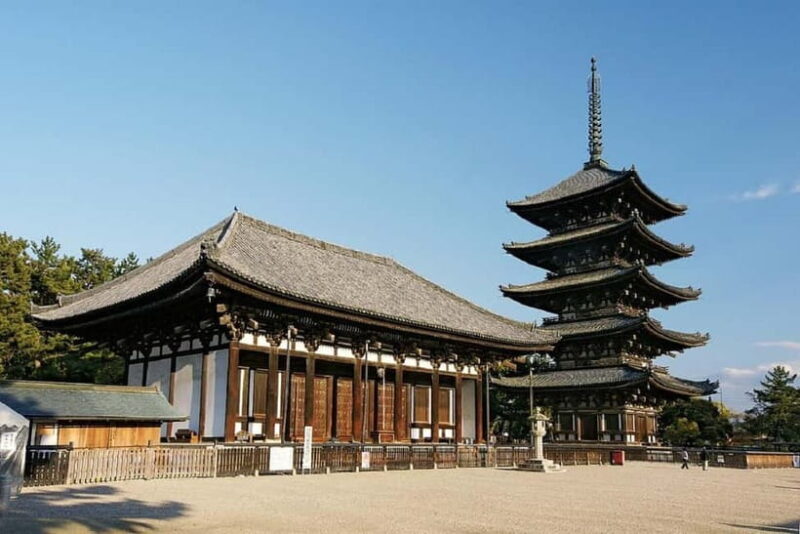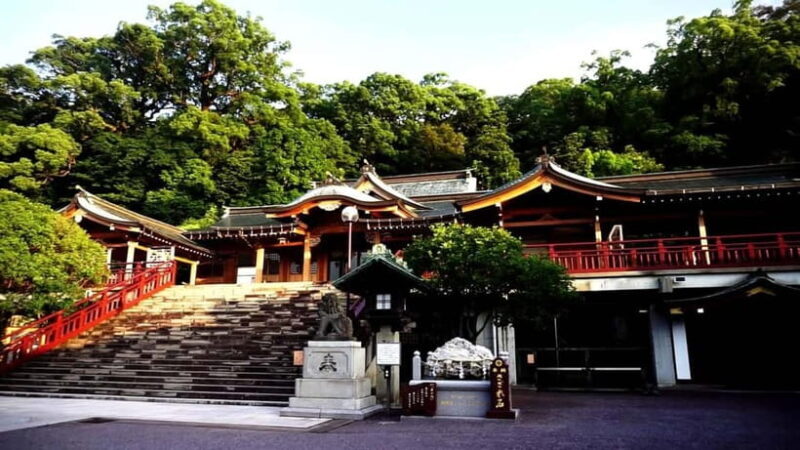Nagasaki: Christianity, Buddhism, and Shinto Tour
Location: Kyushu Region, Japan
Country: Japan
Price: $870 per person
Supplier: PopUP Local Tours
Similar Experiences: See options here
Imagine walking through a city where faith has woven itself into every corner, where Christian, Buddhist, and Shinto traditions coexist and tell stories of resilience, sanctuary, and harmony. For around $870, you gain not just a sightseeing tour, but an intimate journey into Nagasaki’s spiritual soul, guided by friendly experts who help bring each site’s story vividly to life.
What we particularly appreciate is how the tour balances reverent visits with engaging storytelling, making these ancient sites feel alive and relevant. We loved how Oura Cathedral stands as a testament to perseverance, quietly echoing centuries of secret Christians who kept their faith alive under oppressive circumstances. Plus, the Dutch Slope offers a fascinating glimpse into Nagasaki’s history of cultural blending, with historic foreign residences whispering stories of international influence.
A possible consideration? The tour’s pace and walking might be quite demanding for those with mobility issues or low stamina, especially since it involves walking through historic sites with uneven surfaces. It’s best suited for travelers eager to explore through a meaningful, culturally immersive lens rather than just ticking off sights.
This experience appeals most to those interested in religious history, cultural diversity, and authentic stories of survival and faith. If you’re looking for a thoughtful, well-rounded exploration that respects both the spiritual and historical layers of Nagasaki, this tour is a solid choice.
Key Points
- Cultural Diversity: The tour showcases how Christianity, Buddhism, and Shinto coalesce in Nagasaki, offering a rare glimpse into Japan’s spiritual pluralism.
- Authentic Sites: Visit the oldest Christian church in Japan, a Chinese temple, and a Shinto shrine, each with rich stories of resilience and tradition.
- Guided Insight: The tour includes a friendly guide who helps interpret the significance of each site and may even invite you to participate in a short prayer.
- Historical Context: Walk through the Dutch Slope, where old foreign residences reveal Nagasaki’s history as a port of cultural exchange.
- Emotional Connection: Feel the serenity of temple and shrine visits and the awe inspired by stories of faith persistence.
- Practical Details: The tour starts at Nagasaki Station, involves walking, and is suitable for travelers with moderate fitness levels.
Exploring Nagasaki’s Religious Landscape: A Detailed Look

This tour offers a window into Nagasaki’s unique position as a crossroads of faith, history, and culture. It’s not just about visiting beautiful sites but understanding how these spiritual practices have persisted and influenced life in this Japanese port city.
Planning more time in Nagasaki? We've covered other experiences worth considering.
Oura Cathedral: A Testament to Resilience
One of the first stops is Oura Cathedral, Japan’s oldest Christian church, constructed in the 19th century. It stands as a symbol of the survival of Christianity through centuries of suppression. We loved the way this site encapsulates an underground faith that refused to die, even when believers had to worship in secret. The guide might share stories of hidden Christians who kept their faith alive in exile, and you’ll notice how the architecture’s European influence contrasts with local styles, highlighting Nagasaki’s openness to foreign influences.
Visitors often comment on the tranquility inside the cathedral. It’s a place that, despite its age, feels remarkably serene, inviting reflection on resilience amid adversity. The fact that it’s a functioning church adds to its authenticity and spiritual weight.
Kofuku-ji Temple: The Buddhist Influence
Next, we visit Kofuku-ji Temple, an old Chinese temple that introduces visitors to Buddhism’s influence in Nagasaki. Walking through its gates, you’re greeted by the aroma of incense and the gentle chime of temple bells—sensory cues that evoke tranquility and mindfulness.
The temple’s historical importance lies in its role as a bridge between cultures, especially during Nagasaki’s days as a port city. We appreciated how the guide explained rituals like incense offerings and purification rites, which are still part of Japanese spiritual practice today. This site is ideal for those interested in understanding how Buddhism shaped local customs, and you might even be invited to join a short prayer, which adds a personal touch to the experience.
Suwa Shrine: Shinto Rituals and Japanese Spiritual Balance
The Suwa Shrine offers insights into Shinto practices. Here, you’ll learn about the significance of purification rituals and how Japanese people blend Shinto with other spiritual paths. The guide may encourage you to participate in a short prayer, giving you a firsthand experience of Japanese religious etiquette.
The shrine’s calming atmosphere and the interaction with local customs make it a highlight. It’s a place where we felt a genuine connection to Japan’s spiritual fabric, appreciating how even today, Shinto rituals are woven into community life and personal reflection.
More Great Tours NearbyDutch Slope: A Cultural and Spiritual Crossroads
The tour ends with a walk through the Dutch Slope, a row of historic foreign residences once home to Nagasaki’s international community. The architecture narrates stories of cultural exchange, trade, and coexistence. We loved the way these homes symbolize how Nagasaki’s spiritual and cultural worlds intertwined—foreign influence didn’t threaten local traditions but enriched them.
This part of the tour offers a quieter, contemplative moment, perfect for reflecting on how faith and culture shape a city’s identity.
- Echoes of Peace Nagasakis Living Memory Tour
- From Fukuoka: Nagasaki Day Trip Glover Garden, ura Church
- Goto Islands: Udon Making Experience with Certificate (Min2)
- Fukuoka, Saga, Nagasaki Customizable 1-Day Tour
- Kyushu 9-hour chartered day trip Nagasaki
- Nagasaki Heritage Trail: Cathedrals, Bridges & Chinatown
Practical Details and What You’ll Experience
The tour is designed to be accessible and engaging, with a friendly guide helping interpret the significance of each site. It starts at Nagasaki Station’s tram stop—an easy point for most travelers—and ends back at the same location, making logistics straightforward.
Most stops involve walking, often on uneven surfaces typical of historic sites, so comfortable shoes are a must. Bring your camera to capture the architecture and serene landscapes, plus cash for small purchases or donations. Since the tour includes a short prayer experience and visits to sacred sites, modest clothing is advisable, especially for temple and shrine visits.
Lunch isn’t included, so plan to bring snacks or purchase something nearby during or after the tour. The entire experience lasts a few hours, typically around 3-4 hours, making it a manageable addition to a day of sightseeing.
The guide’s language skills are in English and Japanese, ensuring clear communication and cultural sensitivity.
Who this tour suits best:
Travelers eager for a meaningful, balanced look at Nagasaki’s spiritual history, especially those interested in religious resilience and cultural blending. It’s suitable for mature, moderate-fitness travelers who appreciate storytelling and authentic site visits. Not ideal for those with mobility issues or very young children.
Final Thoughts: Who Will Benefit Most?

This tour offers a rare chance to see Nagasaki through the lens of faith and history, making it perfect for culturally curious travelers and those with an interest in religious stories. It’s especially valuable for visitors wanting to understand how faith persisted in a city marked by international influence and historical adversity.
If you’re seeking a contemplative experience that deepens your appreciation of Japan’s spiritual diversity, this tour will not disappoint. It provides a thoughtful, well-paced exploration, with enough historical context and spiritual insight to leave you feeling both inspired and informed.
For travelers who value authenticity over superficial sightseeing, this journey into Nagasaki’s religious tapestry will resonate long after your visit. The combination of sacred sites, engaging storytelling, and a focus on resilience makes it a standout option for those wanting a meaningful connection with Japan’s spiritual landscape.
Frequently Asked Questions

How long does the tour last?
The tour typically lasts around 3-4 hours, making it suitable for a half-day activity.
Where does the tour start and end?
It begins at Nagasaki Station’s tram stop and concludes back at the same location, providing easy access for most travelers.
What should I bring?
Comfortable shoes, a camera, cash, snacks, water, and modest clothing for temple and shrine visits.
Is this tour suitable for children?
It’s best for children over 1 year old, and those with moderate fitness levels, since walking and site visits are involved.
Are meal expenses included?
No, food and drinks are not included; you should plan to bring snacks or purchase at local shops.
Can I participate in a prayer?
Yes, guests may join in a short prayer at certain sites, which enhances the spiritual experience.
Is the tour available in languages other than English and Japanese?
The tour is offered in English and Japanese, ensuring clear communication and understanding.
What if I need to cancel?
You can cancel up to 24 hours in advance for a full refund, offering flexibility in planning your trip.
In the end, this Nagasaki tour is more than just a sightseeing trip—it’s an opportunity to connect deeply with the city’s stories of faith, resilience, and cultural harmony. Whether you’re a history buff, a spiritual seeker, or simply curious about Japan’s pluralistic traditions, you’ll come away with a richer understanding of Nagasaki’s soul.
You can check availability for your dates here:More Tours in Nagasaki
- Nagasaki Like a Local: Customized Private Tour
- Discover Stunning Nagasaki: Self-Guided Audio Tour
- Nagasaki Private Historical Tour with Licensed Guide
- Fukuoka: Hakata & Tenjin Christmas Markets Walking Tour
- Taste Local Life: Nagasaki’s Historical Street Walking Tour
- Nagasaki: Dejima and Dutch Slope Guided Walking Tour
More Tour Reviews in Nagasaki
- Nagasaki Like a Local: Customized Private Tour
- Nagasaki: Glover Garden Admission Ticket
- A Walk Through Suwa Shrine & Kofuku-ji Temple
- Silent Voices, Eternal Peace A Nagasaki Memorial Walk
- Discover Stunning Nagasaki: Self-Guided Audio Tour
- Must-See Nagasaki With A Local: Private & Personalized Walking Experience
More Nagasaki experiences we've covered
- Nagasaki Like a Local: Customized Private Tour
- Nagasaki: Glover Garden Admission Ticket
- A Walk Through Suwa Shrine & Kofuku-ji Temple
- Silent Voices, Eternal Peace A Nagasaki Memorial Walk
- Discover Stunning Nagasaki: Self-Guided Audio Tour
- Must-See Nagasaki With A Local: Private & Personalized Walking Experience
- Nagasaki Private Historical Tour with Licensed Guide
- Fukuoka: Hakata & Tenjin Christmas Markets Walking Tour
- Terraced Rice Paddy Restaurant and Rural Experience
- Taste Local Life: Nagasaki’s Historical Street Walking Tour
- Nagasaki Peace Park and Atomic Bomb Museum
- Nagasaki: Dejima and Dutch Slope Guided Walking Tour
